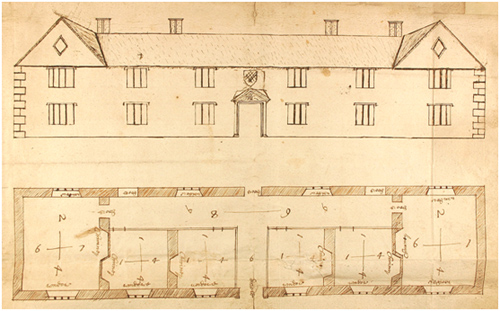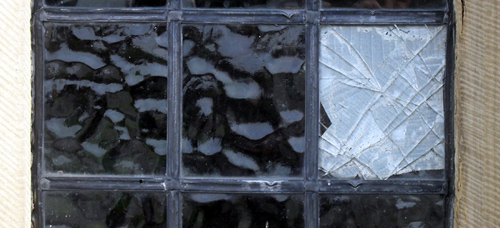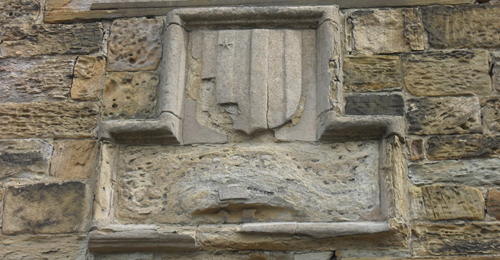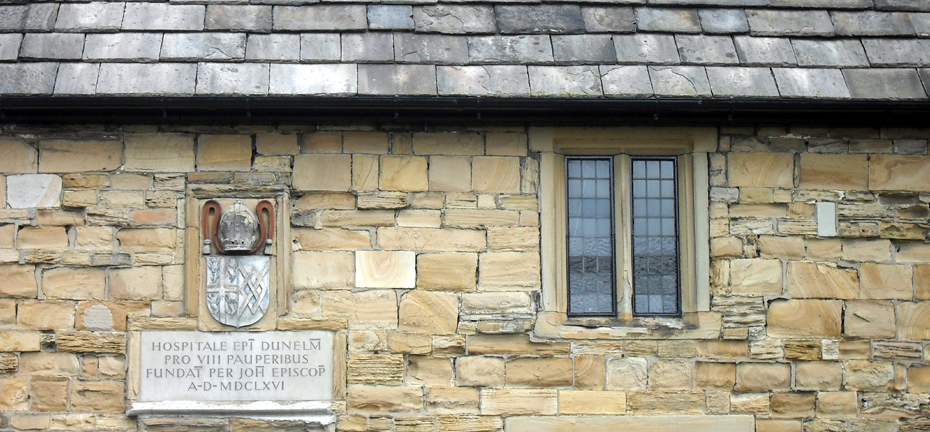
General view of Bishop Cosin's Almshouses, their prominent location on Palace Green a reflection of the Bishop's civic duties, which he obviously took seriously.
What Are Almshouses?
Almshouses are buildings constructed to provide accommodation for poor people who cannot afford to pay rent. They are a form of Christian charity, traditionally for retired or elderly members of a community.
Almshouses are known to have existed in England from as far back as the tenth century.
What is the History of these Almshouses?
Bishop Cosin’s Almshouses were constructed in 1666 by the Bishop of Durham, John Cosin. They were constructed on the site of an earlier building, the song and grammar school of a previous Bishop of Durham, Langley, built in 1414.

A 17th-century sketch plan and elevation of the Almshouses by John Langstafe, the man who designed them. The original document is in Durham's Palace Green Library (Mickleton and Spearman MS 91 f.2).
How did they function?
The original foundation charter for the Almshouses indicates that the building contained 8 rooms to provide accommodation for 4 men and 4 women who had to be unmarried and 'honourable' citizens.
Three of the men and three of the women had to be natives of the city of Durham, or to have lived in it for at least 20 years. The fourth man and woman had to be from the nearby parish of Brancepeth, where the John Cosin had previously been rector.
Finances:
The sum of 70 pounds per year was endowed for the support of the occupants and the upkeep of the building. Each of the 8 occupants received an annual stipend of 6 pounds, 13 shillings and 4 pence, paid in quarterly installments. They received an additional 15 shillings on St Bartholomew’s day for buying fuel and repairing the windows. One pound per year was allocated to general building repairs and 5 pounds per year were to be spent on buying gowns for the occupants every third year. In addition, 4 pounds a year was to be paid in quarterly installments to “some honest woman to be nominated by the bishop and his successors” to take care of the residents if they were sick.

Broken windows: then as now, provision had to be made for damage to vulnerable elements of the building.
Rules:
The occupants of the almshouses were expected to live as upright members of the community. They were to attend morning and evening services at the cathedral, walking together in pairs, wearing their gowns, and processing as soon as the bells started to toll to ensure that they would not arrive late. Moreover, they were to say their prayers first thing in the morning and last at night – the prayers were prescribed and written in each of their chambers. They were to live peacefully, quietly and humbly, refrain from playing cards or gambling, avoid taverns and Alehouses, and lodge in the Almshouses at all times.
If any of the occupants broke the rules, following two or three warnings the Bishop could decide evict them, and find a more suitable occupant.

Langley's coat of arms. It is to John Cosin's credit that, when building his almshouses, he recognised and maintained the institution founded by his predecessor 250 years earlier.
The Building as an Institution
John Cosin made sure that his Almshouses included spaces for a grammar school and a music school (for plainsong), thereby continuing the functions set out by Bishop Langley in his 15th century building that occupied the same site. In acknowledgement of Langley’s own endowment, Langley’s coat of arms is carved on the sections of the building corresponding to the two schools he founded. The Latin inscriptions, now weathered to the point of being illegible, once read, “School for learning the rudiments of grammar,” and “School for plainsong and the art of writing”.
This detail is telling: Cosin was adding to an existing endowment, and made sure to acknowledge the efforts of his predecessor.

The Great Auk, a large flightless bird hunted to exinction by 1850. The University Museum, relocated to Cosin's Almshouses in 1876, included a stuffed great auk, purchased in 1830.
Later history of the building:
The Almshouses remained in use for their original purpose until 1837, at which point the property was given over to Durham University. New almshouses were constructed nearby to replace them.
Cosin’s Almshouses were used for student accommodation until 1876. At that point they were used to house the University Museum, whose ornithological collection was suffering due to damp - being located on the river banks in an old fulling mill.
Conversion to a museum required the removal of the building's interior walls -giving it its present appearance. In addition to the collection of stuffed birds (which included a Great Auk, purchased for £5 in 1830), the museum comprised of a herbarium; the smaller finds from the Roman Fort at Binchester from excavations around 1880; weapons found on the site of the Battle of Neville’s Cross; and the personal effects of a polish resident of Durham, Count Joseph Borulaski, a much-celebrated dwarf. The collection was dispersed around 100 years ago, and the Almshouses currently function as a café.
The part of the building that housed the former grammar school, founded almost 600 years ago still serves an educational purpose: it is now used as University of Durham classrooms.

